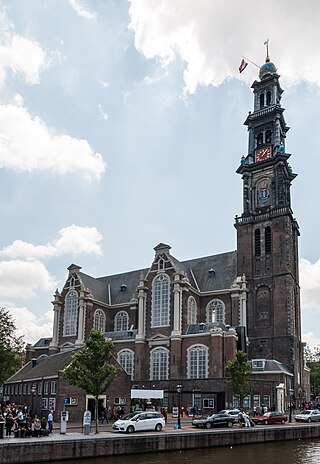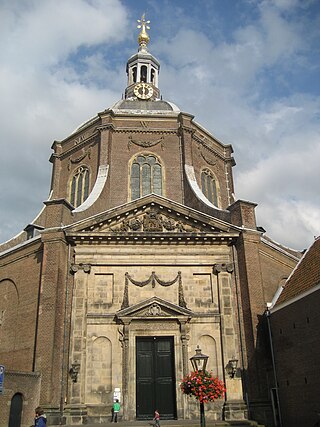
Zutphen is a city and municipality located in the province of Gelderland, Netherlands. It lies some 30 km northeast of Arnhem, on the eastern bank of the river IJssel at the point where it is joined by the Berkel. First mentioned in the 11th century, the place-name appears to mean "south fen". In 2005, the municipality of Zutphen was merged with the municipality of Warnsveld, retaining its name. In 2021, the municipality had a population of 48,111.

The Dom Tower of Utrecht is the tallest church tower in the Netherlands, at 112.32 metres (368,5 feet) in height. It is considered the symbol of Utrecht. The tower was part of St. Martin's Cathedral, also known as the Dom Church, and was built between 1321 and 1382, to a design by John of Hainaut. The cathedral was never fully completed due to lack of money. Since the unfinished nave collapsed in 1674, the Dom tower has been a freestanding tower. The tower stands at the spot where the city of Utrecht originated almost 2,000 years ago.

The Westerkerk is a Reformed church within Dutch Protestant Calvinism in central Amsterdam, Netherlands. It lies in the most western part of the Grachtengordel neighborhood, next to the Jordaan, between the Prinsengracht and Keizersgracht.

The Grote Kerk or St.-Bavokerk is a Reformed Protestant church and former Catholic cathedral located on the central market square in the Dutch city of Haarlem. Another Haarlem church called the Cathedral of Saint Bavo now serves as the main cathedral for the Roman Catholic Diocese of Haarlem-Amsterdam.

Hendrick de Keyser was a Dutch sculptor, merchant in Belgium bluestone, and architect who was instrumental in establishing a late Renaissance form of Mannerism changing into Baroque. Most of his works appeared in Amsterdam, some elsewhere in the Dutch Republic. He was the father of Pieter and Thomas de Keyser and Willem, and the uncle of Huybert de Keyser, who became his apprentices and all involved in building, decoration and architecture.

The Oude Kerk is Amsterdam's oldest building and newest art institute. The building was founded about 1213 and consecrated in 1306 by the bishop of Utrecht with Saint Nicolas as its patron saint. After the Reformation in 1578, it became a Calvinist church, which it remains today. It stands in De Wallen, now Amsterdam's main red-light district. The square surrounding the church is the Oudekerksplein.

The Munttoren or Munt is a tower in Amsterdam, Netherlands. It stands on the busy Muntplein square, where the Amstel river and the Singel canal meet, near the flower market and the eastern end of the Kalverstraat shopping street.

Pieter Hemony and his brother François Hemony were the greatest bellfounders in the history of the Low Countries. They developed the carillon, in collaboration with Jacob van Eyck, into a full-fledged musical instrument by casting the first tuned carillon in 1644.

The Zuiderkerk is a 17th-century Protestant church in the Nieuwmarkt area of Amsterdam, the capital of the Netherlands. The church played an important part in the life of Rembrandt and was the subject of a painting by Claude Monet.

JonkheerJacob van Eyck was a Dutch nobleman, composer and blind musician. He was one of the best-known musicians of the Dutch Golden Age, working as a carillon player and technician, a recorder virtuoso, and a composer. He was an expert in bell casting and tuning, and taught Pieter and François Hemony how to tune a carillon. Van Eyck is credited with developing the modern carillon together with the brothers in 1644, when they cast the first tuned carillon in Zutphen. He is also known for his collection of 143 compositions for recorder, Der Fluyten Lust-hof, the largest work for a solo wind instrument in European history.

The Noorderkerk is a 17th-century Protestant church in Amsterdam, The Netherlands. The Noorderkerk is located along Prinsengracht canal, on Noordermarkt square. The church is used for Dutch Reformed Church services and is also used regularly for classical music concerts.
Vanden Gheyn, Van den Gheyn or Van den Ghein was a family of bellfounders and carillon makers. The bell foundry was established in 1506 in Mechelen and active until the 20th century. They have been called "the most famous family of bellfounders [Belgium] has had".

The Marekerk is a Protestant church in Leiden, located at the Lange Mare and the Oude Vest canal. The church can be easily seen from the Oude Vest and the Burcht van Leiden by its round dome.

The Nieuwe Toren is located at the Oudestraat in the city of Kampen, in the Netherlands. This Carillon tower was built in the period between 1649-1664 partly according to a design by Philips Vingboons. The lower brick-built part was erected by the Edam mill maker Dirck Janzn. The design for the lantern was made by Philips Vingboons, which may have originally been intended for the Town hall now the Royal Palace of Amsterdam. The construction work went through many setbacks, the work even came to a standstill during the period 1655-1660. It was declared a Dutch National Monument (Rijksmonument) in 1972.

The Toren van Goedereede is a gray square brick tower in Goedereede, Netherlands, 39.5 metres (130 ft) high, belonging to the Catharina church. It was built in 1512. From 1552 to 1912 the tower served as a lighthouse, and went through various changes during this period. Today it has been restored and is a museum, housing a carillon.

The Waag building is a National monument (Rijksmonument) listed building on the Waagplein in Alkmaar in the Netherlands. On this square Waagplein every Friday from April till the second week of September, the famous cheese market is held. The Dutch Cheese Museum and the tourist information Office (VVV) are also in the building. In the tower is a famous carillon weekly played by a carillonneur and also automatically by a drum chiming the quarters of the hour. There is also the famous automatic horse with knights play in the tower with an automatic trumpetplayer.

The 'Drommedaris' is the southern gateway of the city Enkhuizen. It is the best known building in Enkhuizen.

Michiel Servaesz. Nouts or Nuyts was a Dutch Golden Age painter who also served as Amsterdam's town musician.

St Willibrordus is a basilica located in the center of the fortress city of Hulst in the east of Zeelandic Flanders, the Netherlands. The church is dedicated to the missionary St. Willibrord, often called the apostle of the Benelux countries. Although the nave dates from the 13th to 15th centuries, the central tower was destroyed several times, most recently in the Second World War. The current tower's modern appearance dates from the 1950s. The church contains the painting The Good Samaritan by Jan Baptist Maes (1794–1856) from Ghent. The scenes of the Way of the Cross were painted by Jan Jozef Deloose (1769–1849) from Sint-Niklaas. The frames are by the Ghent sculptor P. Pauwels.






















